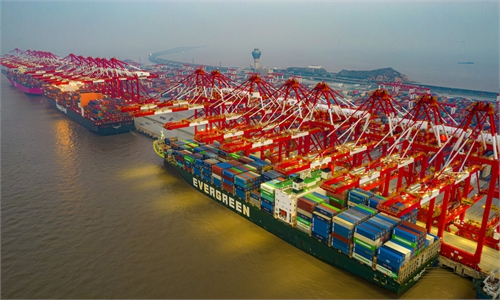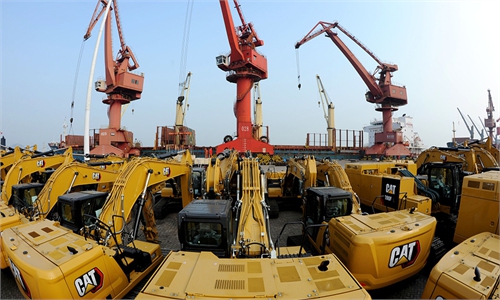
The Houhai area in Nanshan District of Shenzhen, south China's Guangdong Province, September 17, 2020. Photo: Xinhua
The international economic situation is sharply worsening. The IMF has announced a downgrade of growth predictions for 143 countries. US inflation has reached 8.5 percent, the highest in 40 years - US inflation-adjusted wages fell 2.7 percent in the last year. High US inflation is forcing the Federal Reserve to raise interest rates, slowing its economy. In other advanced economies, inflation is higher - in Spain and the Netherlands it is 10 percent. With slowing growth and rising inflation, much of the world economy is heading towards "stagflation." Confronted with negative international trends, China's economy has rightly launched a moderate stimulus package - shown recently by reduction of China's Reserve Requirement Ratio.Compared to these international trends, even a cursory factual examination shows that China's economy is by far the most powerful global centre of stability and growth. China's inflation is 1.5 percent - fully in control and less than one fifth that of the US. In the two years since COVID-19 began, China's GDP has grown by 10.5 percent and US' by 2.1 percent - China's economy growing five times as fast as US economy.
Despite these obvious facts, US media claim that due to Shanghai's COVID-19 outbreak and the Russia-Ukraine conflict, China faces serious economic problems. This is so far out of line with the major facts already given it is tempting to dismiss it as pure propaganda and pays no more attention. Nevertheless, it is instructive to look further into this falsification as it indicates the real situation of the world economy and the place of China and the US within it.
Regarding COVID-19, US claims can be dismissed immediately. Shanghai's COVID-19 outbreak is significant, but China is suffering zero daily deaths whereas the US suffered 956 in a country with less than a quarter of China's population. If the US had the same population as China, the US would be suffering over 4,000 deaths daily compared to China's zero. Since the pandemic's outbreak, the Chinese mainland has suffered 4,638 deaths compared to the US' almost 1 million.
Turning to the economy, China is similarly far outperforming the US. Indeed, US policy is destabilising both itself and the world economy.
US Treasury Secretary Janet Yellen claimed that US inflation surge was due to the "enormous" economic effects of the Ukraine war. This is entirely untrue. By far, the largest part of the US inflationary wave came before Ukraine. US inflation rose from 2.5 percent in January 2020 to 7.5 percent in January 2022. As the Wall Street Journal noted, "This Isn't Putin's Inflation."
What created this inflationary wave was the type of US stimulus packages launched in response to COVID-19. As it clarifies economic trends, it is illustrative to compare this failure of the US stimulus packages to those launched in China.
Since COVID-19 began, the US launched a budgetary stimulus of $900 billion in December 2020, and $1.9 trillion in March 2021 - $2.8 trillion in total. The US government borrowing peaked at 27 percent of GDP and US money supply increased by 27 percent year on year - both the highest in US peacetime history. Structurally, these packages completely focused on consumption - on the economy's demand side. From 2019-21, 98 percent of increase in US GDP was in consumption and only 2 percent in net investment. With a huge demand increase, and almost no increase in supply and investment, inevitably a huge US inflationary wave was ignited. As the Wall Street Journal put it, "This inflation was made in Washington, D.C."
Compare China's 7 trillion yuan stimulus package to counter the 2008 international financial crisis. This focused not only on consumption but on investment - the economy's supply side. In two years following the launch of this package, 46.3 percent China's increase in GDP was in consumption and 39.9 percent in net fixed investment. China's stimulus package was a balanced mixture between the economy's supply and demand sides. China's economy far outperformed that of the US - since 2007 the US economy grew by 24 percent while China's grew by 177 percent.
The same is occurring now. Data for the beginning of 2022 confirms China launched a moderate stimulus package - again focused not only on consumption but also investment. Taking January-February compared to December the annual increase in retail sales rose from 1.7 to 6.7 percent, fixed investment rose from 4.8 to 12.2 percent, industrial production rose from 4.3 to 7.5 percent. Unlike the US, China's balanced development led to no significant inflation.
China therefore has space to loosen its monetary policy, if necessary, faced with negative international trends - unlike the US which is trapped by high inflation in monetary tightening. In summary, not merely has China outperformed all other major economies in the last period, it is clearly in the best position to continue to do so.
The author is a senior fellow at Chongyang Institute for Financial Studies, Renmin University of China. He was previously Director of Economic Policy for the Mayor of London. opinion@globaltimes.com.cn


